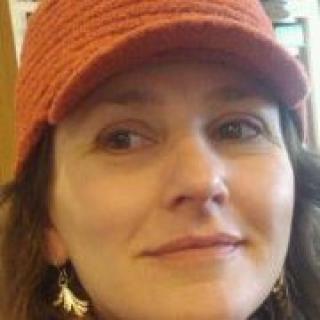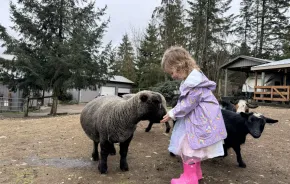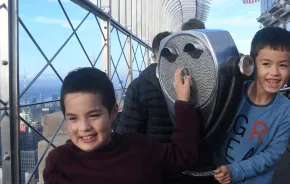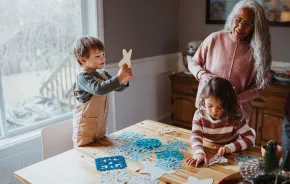 Marc Brown, the creator of the phenomenally popular Arthur books and PBS television show, is coming to town as the keynote speaker at Program for Early Parent Support’s annual fundraising luncheon on April 29.
Marc Brown, the creator of the phenomenally popular Arthur books and PBS television show, is coming to town as the keynote speaker at Program for Early Parent Support’s annual fundraising luncheon on April 29.
In a phone chat from his studio in Massachusetts, Brown talked easily about influences on his work, favorite “Arthur” character (hint: she’s small, vocal and “gets all the good lines”), and passionate conviction that parents need support in what he calls “the most difficult job in the world.”
KC: You’ve talked in the past about how you’ve used your early life as material for the Arthur books – there really was a Grandma Thora, and D.W. is based on your sister, Kim. Does that mean that you’ve put a lot of yourself as a kid into Arthur?
MB: I looked exactly like him in third grade. Right now I have glasses just like Arthur. I didn’t realize they looked just like Arthur until I got them home, and my wife [author Laurie Krasny Brown] said, “You look just like Arthur!”
KC: You’ve also said that you pulled the idea of an aardvark out of the air, when you were inventing stories for your young son. How did Buster end up as a rabbit?
MB: People remind me of animals, and Buster was based on my best friend in third grade, Terry Johnson. I thought he looked an awful lot like a rabbit. He was a real practical kid, and he spent most of the third grade in the principal’s office.
KC: Which one of your characters do you most enjoy writing?
MB: Well, I love writing for D.W. I think the most fun I’ve had is D.W.’s Guide to Preschool, writing as if she’s talking to the viewer. It just was a lot of fun to write. She has all the good lines. Arthur just sets her up. He’s the straight man for D.W.’s comedy routine.
KC: How do you decide which topics to cover, and how do you manage to keep it so relevant to kids?
MB: I guess everyone has a special ability, and that’s mine. I don’t know how I got that. I can’t change the oil in my car. Millions of kids think I’m funny, but my family doesn’t find me so amusing. If we pay attention, somehow we pick up the clues for what we’re good at in life, and I guess I was just lucky enough to pay attention and stubborn enough to persist. It certainly wasn’t easy to make a living doing this, starting out. I think I have to credit my success to teachers and librarians, because they were the first ones who encouraged me and gave me positive feedback for what I was going. I paid attention. I follow directions well.
KC: Do you have any new "Arthur" books in the works?
MB: I just finished a “Step Into Reading” book for Random House about Arthur moving to New York City. Laurie and I are getting ready to move to New York City and spend half the year there. The books have always been germinated from something that’s going on in my life. I remember when I wrote Arthur’s Eyes a long time ago. I was going through a divorce, and I thought it [the book] really didn’t have to do with getting glasses at all. It had to do with adapting to changing circumstances. Writing and illustrating picture books is the cheapest form of therapy you can ever find.
KC: Can you tell me about your new collaboration with Judy Sierra, Born to Read?
MB: It will be published in August, 2008. It’s a wonderful book. The older I get, the more I want to do books that are relevant and challenge me. I love working on new Arthur shows, but I never expected that adventure to take over my life for as long as it has. I need to also challenge myself as an artist. I really studied art, and I never really thought I’d become an illustrator. When I worked on the first one, Wild about Books, I thought was the best gift I’ve ever had in my life as a vehicle to be an artist. Then I got this new manuscript and I couldn’t believe she had written an even better book. It’s the story of a baby who starts to read in his crib, and the power that reading gives him in his life. It’s going about it in such a positive way, to really portray reading as power. I just fell under the spell of this book, and had a wonderful time doing these paintings on gesso board.
KC: You’ll be in Seattle this month to speak at the annual Program for Early Parent Support luncheon. Can you give us a preview of what your talk will be about? Have you been to Seattle before?
MB: Yes, and it’s one of the most beautiful places in the world. I love that city. I want to talk a little bit about being a parent – a particular struggle that I had with one of my children, and talk about the resources that helped me through that. I don’t have a whole lot of time, so I’m really trying to craft this talk so I can get a lot in. I know I’d be cheating people if I didn’t talk a little bit about my work, and what led me to TV, and what I feel about that as a medium for telling stories, and talk a little bit about my good friend Fred Rogers who was a wonderful teacher and role model. I’d love to share my story Born to Read. It’ll be the second place I’ve read it to a group of people.
KC: How did you get involved with PEPS?
MB: I’m involved with a speaker’s bureau, and somehow my name was brought up, and the date worked for me. So I’m going to be on an airplane. I do a few talks a year, and I really enjoy it. It really allows me to be involved with who I work for. I think any group that supports parents is wonderful. We need all the support we can get.
KC: You may have heard that the Dalai Lama is coming to town this month for a conference with area educators and parents on early learning and emotional intelligence, and their connection to the development of compassion. The group Seeds of Compassion is bringing this all together, and in my work with them, I’ve noticed that your name has come up on lists of picture books for parents – especially your "Dino Life Guides for Families." How did you come to be involved with a project that deals so specifically with teaching kids how to manage tough life situations?
MB: That’s Laurie’s project – we have to share the credit here. She has done such a wonderful job, taking those difficult subjects that all of us deal with at some times in our lives. I really like the way those books are conceptualized. I had very little input on the text, but I really had a good time doing the pictures. The divorce book was our first collaboration in the series. We had both been divorced, and I had two sons, and I went to the library to get book about divorce, and they were so disappointing. They most upbeat one was My Dad Lives in a Downtown Motel, and it was very grim. And I thought this has nothing to do with our situation. Where are all the good books about divorce?
When Laurie and I did meet, we talked about doing books together. [Laurie Krasny Brown was co-director with Howard Gardner of Harvard University’s Project Zero, studying children and media.] They hired me to come in and work on a study. They were interested in the importance of illustration in picture books and how they affect a child’s imagining. At that point, illustrators weren’t event getting credit in the spines of books. I was very interested in the work they were doing over there.











